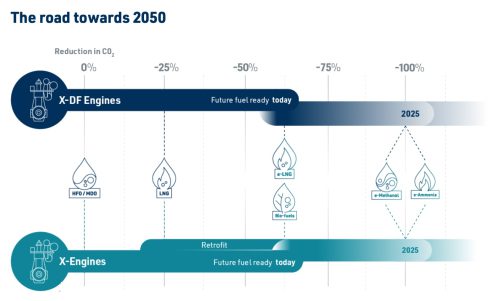28 November 2024
Methanol-Ammonia Engines by WinGD Leading the Way

Swiss engine designer WinGD has announced that its engines will be able to run on methanol-ammonia. This will take action from 2024 and 2025 respectively.
Core Design
WinGD’s methanol-ammonia engines will be based on their well-established diesel-fuelled X models and dual-fuel X-DF engines. The company’s core engine types have the ability to use zero-carbon or carbon-neutral fuels such as ammonia and methanol. Consequently, the methanol-ammonia engine versions will give ship operators flexibility in how they reduce emissions.
“Our commitment to deliver engine technologies to enable the use of clean fuels by 2025 means that ship owners and operators can already invest in ships that are ready to use ammonia and methanol today, safe in the knowledge that WinGD will have the technologies available to power their vessels reliably, efficiently and cleanly.”
Dominik Schneiter, Vice President Research & Development, WinGD
Moreover, both X and X-DF engine series are already compatible with low-carbon fuels – liquid biofuel or biogas respectively. Hence, they can provide significant reductions in greenhouse gas emissions. For instance, the tanker operator Terntank have been bunkering and operating its X-DF engines on liquefied biogas since 2018. Therefore, the full, long-term use of carbon-neutral or zero-carbon fuels is the next step on this pathway.
Further Flexibility
The methanol-ammonia engine maker can already optimize the engines’ emissions in line with IMO’s incoming EEXI regulations.
Namely, hybridization of the power source arrangement is one option. Thus, WinGD offers system integration services that maximize fuel efficiency. By selecting and sizing hybrid components and the electrical system in parallel with the main engine they achieve enhanced efficiency.
Company’s Projection
The timeframe for methanol-ammonia capability is part of a wider ambition to grow sales of multi-fuelled engines. Capable of operating on carbon-neutral fuels, the sales estimates reach 50% of the company’s order book by 2030.
This estimation is in line with the industry predictions for the availability of such fuels at scale. Additionally, the industry expects the establishment of a viable fuel choice for deep-sea vessels by 2030.
“By 2030, many of the ships that will be sailing in 2050 – the date of IMO’s greenhouse gas emission reduction target – will already have been ordered… Our clean fuel engine technologies will be available well before then and will be based largely on our current technologies, allowing us to support ship owners and operators in their decarbonisation choices whenever they make them.”
Volkmar Galke, Director of Global Sales, WinGD

Thoughts from the Nerd
Despite the fact that the upcoming EEXI regulations may not vastly affect the engine performance, it is exciting to discover and establish new alternatives to produce power.
Another rousing project is the world’s first tug with methanol fuel cells from Svitzer. The same recruited designer will move to the development of another methanol-fuelled crew transfer vessel.
Hope that you also feel the thrill of witnessing the elimination of emissions through innovative technological advancements for ship propulsion.
Source: WinGD


